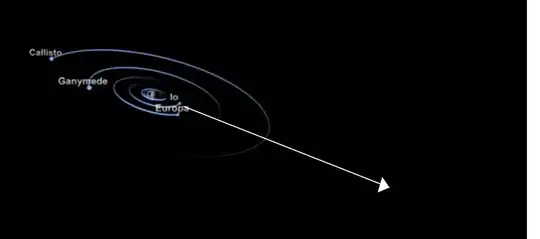The assumption is made that the planets of our solar system all have elliptical orbits elongated in the same direction. Further, generalized to that orbits around any object with its own orbital vector should have elliptical orbits, including moons orbiting planets.
-
4Not sure what you're asking here, but the assumption that the orbits for all planets are elongated in the same direction is not correct: each planet has a different eccentricity vector. – Dec 14 '19 at 13:04
-
Ok. If their ellipse vector is completely different then the idea would be wrong. Do you know any good source for where to see the different eccentricity vectors? – Kornelia Dec 14 '19 at 13:11
-
In images they're often portrayed as aligned, http://www.pas.rochester.edu/~blackman/ast104/planet_orbits-inner-sideview.gif – Kornelia Dec 14 '19 at 13:12
-
and, from my own reading here, it looks like they are pretty much aligned. If they are not, the idea is moot, but, seems corroborated by this post for example, https://www.quora.com/What-does-a-diagram-of-the-actual-orbital-path-of-planets-in-the-solar-system-look-like – Kornelia Dec 14 '19 at 13:17
-
Well that particular subset of TNOs is fairly aligned. Pick another subset, and you'll see it's not, e.g. Pluto and Orcus – Dec 14 '19 at 13:20
-
OK. So, the planets are fairly aligned? – Kornelia Dec 14 '19 at 13:21
-
3It's difficult to see the directions of eccentricities for the major planets because the eccentricities are low. But no, in general the eccentricity vectors are not aligned despite the orbits being fairly coplanar. – Dec 14 '19 at 13:22
-
But you said they were fairly aligned. They tend to be aligned in most images, and, just from simple reading. Do you happen to have a good source where I could educate myself in the exact eccentricity vectors, for example the source you base what you say on? – Kornelia Dec 14 '19 at 13:25
-
and if that source is in some text book not accessible online, some other source – Kornelia Dec 14 '19 at 13:26
-
1You appear to be confusing coplanarity with alignment of the eccentricity vectors. I can draw lines in different directions on the same (flat) sheet of paper: the lines are coplanar because they are drawn on the paper, but they are not going in the same direction (aligned) – Dec 14 '19 at 13:29
-
Nope. The question was an honest question. If it is clearly wrong, then I'd take that in, just need to see the evidence. You brought up that the eccentricity vector was not aligned for the planets. You mentioned coplanar alignment as well, I have not. Coplanar is along different axis than what the question is about. Overall, I'm just interested in the evidence, it was, genuinely, an honest question from myself, and if it is clearly wrong then I'll adjust my beliefs. – Kornelia Dec 14 '19 at 13:43
-
Ok looking at where you've drawn the arrows, it looks like you're taking the projection effect of showing the orbits from the side as representing the actual eccentricity of the orbits. The orbits (apart from Pluto in the first diagram) are actually near-circular, they look elliptical because of projecting from 3D space to 2D space. A circle viewed from an angle that's not face-on will look like an ellipse. – Dec 14 '19 at 14:36
-
Yes largest eccentricity Pluto, 0.25, still small. It isn't that I misunderstand that. It seemed to me like if the sun itself was moving, that would affect the orbits of the planets. It'd be good to have accurate data for the eccentricity vectors, if you happen to have a good source, feel free to point to it. – Kornelia Dec 14 '19 at 14:41
-
Forget Pluto for the moment. In your second diagram, the orbits of Jupiter's major moons are basically circular. The diagram is showing them in 3D. The arrow you've drawn doesn't represent anything about the system, that direction is a result of the camera view direction in 3D space! – Dec 14 '19 at 14:46
-
This is what the moon orbits look like when you view the system from the top down - see that the orbits are basically circular! – Dec 14 '19 at 14:48
-
Yes, you said that in previous comment. The idea itself is disproven if the elliptical orbits (whether or not eccentricity is large) are not aligned in a similar direction. Would be good to have evidence of that, if there is a good source for it. – Kornelia Dec 14 '19 at 14:48
-
here, eccentricity of them. https://www.coursehero.com/qa/attachment/3387485/ think of image as artist impression. overall, idea disproven if eccentricity vector is not aligned, or, to some extent aligned. would be good to have a source to see that. – Kornelia Dec 14 '19 at 14:49
-
I linked sources in my answer, a nautical almanac has up to date ephemeris data and orbital elements, as has the linked jpl site. The sun is moving, but not relative to the planets. The planets are gravitationally bound to the sun, they orbit the sun and the sun orbits the galactic centre, together with its neighbour stars. – Dec 14 '19 at 14:51
-
The moons in the diagrams are Io, Europa, Ganymede and Callisto. These have nearly circular orbits. That table includes several of the outer moons, which ARE on eccentric orbits but are NOT on the diagram! – Dec 14 '19 at 14:52
3 Answers
Actual diagrams, rather than made-up artists' impressions, can be found at NASA JPL. https://ssd.jpl.nasa.gov/?orbits
The ellipticity of planetary orbits are in general quite small and they are not aligned. http://www.met.rdg.ac.uk/~ross/Astronomy/Planets.html gives a table of orbital elements in the solar system. The longitudes of perihelion (labelled as "$\sim \omega$") are different - indicating that the "eccentricity vectors" (as you put it, and keep asking for) are pointing in essentially random directions around the ecliptic plane.
Many of the diagrams that you see are drawn from perspectives that are not looking straight down on the ecliptic plane. If that is the case then of course you see (highly) elliptical shapes (even when the orbits are nearly circular) that appear aligned. That is merely a perspective effect.
- 151,483
- 9
- 359
- 566
-
If they are not aligned then the idea was wrong. This image, from the link you posted, does show that they look pretty aligned. https://imgur.com/a/Wpbokcu. Is it using wrong data (as it might be focusing more on accuracy for objects further out?). antispinwards comments also mentioned "fairly aligned". – Kornelia Dec 14 '19 at 14:02
-
2I think I see your misunderstanding! That image shows a view of the solar system from one side. The ellipses that you see are not due to Keplerian orbits, but just due to (almost) circular orbits that are being viewed from the side. There is no alignment, the planets are not pretty aligned Your posted image only shows a perspective effect. – James K Dec 14 '19 at 14:49
-
aware of that yes. the elliptical orbits of planets is not a perspective effect though. the idea was simply based on if they were aligned. if they are not, would be good to have source for that. – Kornelia Dec 14 '19 at 15:01
-
You could do so tonight. When the suns sets, you see Venus in the west and Saturn slightly above. That shouldn't happen if they were in the same ecliptic. Maybe use goggles (but not for the sun !). – Dec 14 '19 at 15:04
-
-
1@Kornelia - the table linked in this answer is a source for the eccentricity vectors not being aligned. The longitude of perihelion ("~omega") column gives an indication of which way the long axis of the ellipse is pointing. If the orbits were aligned, these values would all be the same. You can't see this very well on a diagram because most of the orbits are near-circular. – Dec 14 '19 at 15:31
-
"This image, from the link you posted, does show that they look pretty aligned." @Kornelia Please read the explanatory caption to that image, which says it is an "oblique" view of the solar system. – ProfRob Dec 14 '19 at 15:43
First of all, to make absolutely sure we're on the same page about the shape of the elliptical orbits, seeing as there's been some confusion in the comments, I've included the same two pictures from both top down and at an oblique angle.
Which directions are the planets' orbital eccentricities pointing to?
You can find out the longitudinal direction by adding the longitude of the ascending node to the argument of perihelion. This information is all in wikipedia but I've gone and processed it anyway.

Mercury is a bit of an anomaly because its orbit precesses over time and so the direction of its major axis changes very slowly (it takes 12 million orbits for the major axis to do a full 360 degree sweep). The other planets have their major axes scattered fairly evenly, by my eye.
Which direction is the sun moving in?
This was answered here. The Sun is moving through the galaxy in a direction 60 degrees from the ecliptic, which is not aligned with the eccentricities of any planets.
- 4,155
- 1
- 15
- 38
No, they do so because of the impulse of the cloud the solar system formed from. This impulse is preserved in the orbits of the solar system bodies, and in their rotations.
It is a dynamic system with dependencies and influences through gravity. Objects can get captured, flung around, forced into resonances ...
https://en.wikipedia.org/wiki/Formation_and_evolution_of_the_Solar_System
https://en.wikipedia.org/wiki/Orbit
The orbital plane ("ecliptic") is different for all objects. Differences may be small. The solar system's ecliptic is defined by earth's orbital plane mostly for [nautical reasons][1] . Other planets and objects have an inclinitation in relation to that plane.
Further links that might help:
https://en.wikipedia.org/wiki/Astronomical_Almanac
https://en.wikipedia.org/wiki/Fundamental_plane_(spherical_coordinates)
-
Appealing to settings during original creation does seem a bit lika logical fallacy to me. If you take a different angle, consider your "creation" setting as true. If then, the solar system were to move with a vector that is aligned with ecliptic, would that, in any way, affect the orbits in that system? – Kornelia Dec 14 '19 at 13:03
-
1


